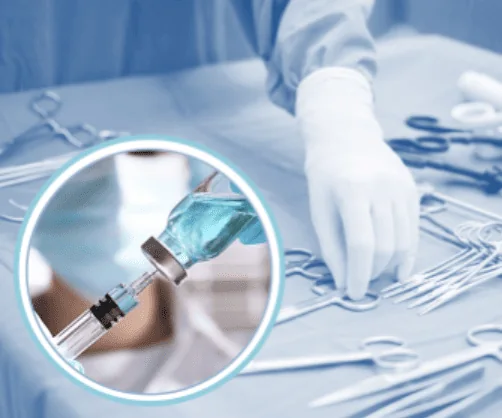PROPHYLAXIS ANTIBIOTIC IN SURGERY
Introduction
การให้ยาปฏิชีวนะเพื่อป้องกันการติดเชื้อที่ตำแหน่งแผลผ่าตัด มีเป้าหมายเพื่อป้องกันไม่ให้เกิดการติดเชื้อบริเวณที่ตำแหน่งแผลผ่าตัดภายหลังการผ่าตัด (surgical site infection) เกิดขึ้น การให้ยาปฏิชีวนะที่เหมาะสมมีความสำคัญต่อการป้องกันและยับยั้งการเกิดปัญหาเชื้อดื้อต่อยาปฏิชีวนะหลังการผ่าตัด

CLINICAL
ปัจจัยที่เกี่ยวข้องกับการติดเชื้อที่ตำแหน่งผ่าตัด
1. ปัจจัยด้านผู้ป่วย (host)
- อายุ เด็กและผู้สูงอายุมีโอกาสเกิดการติดเชื้อที่ตำแหน่งผ่าตัดได้มากกว่าวัยอื่น
- ความอ้วน (obesity) มีดัชนีมวลกาย (BMI) มากกว่าหรือเท่ากับ 30
- ภาวะขาดสารอาหารก่อนผ่าตัด
- ภาวะโรคร่วมที่เป็นอยู่ก่อนผ่าตัด เช่น ผู้ป่วยโรคเบาหวาน หรือโรคมะเร็งบางชนิด เช่น มะเร็งเม็ดเลือดขาว หรือมะเร็งกระดูก
- การได้รับการรักษาด้วยยากดภูมิคุ้มกันก่อนการผ่าตัด เช่น ยากลุ่มสเตียรอยด์ เป็นต้น
- การสูบบุหรี่ต่อเนื่องเป็นเวลานาน
- การติดเชื้อที่มีอยู่เดิมในตัวผู้ป่วยก่อนผ่าตัด
2. ปัจจัยด้านสิ่งแวดล้อม (environment)
- การเตรียมผิวหนังบริเวณผ่าตัดไม่เหมาะสม
- ชนิดของแผลผ่าตัด มีความเสี่ยงต่อการติดเชื้อแตกต่างกัน ได้แก่ clean wound, clean-contaminated wound, contaminated wound และ dirty wound
- ปัจจัยที่เกี่ยวข้องกับการผ่าตัด ประกอบด้วย
i. ระยะเวลาในการผ่าตัดที่ยาวนาน มีโอกาสเสี่ยงต่อการติดเชื้อมากกว่า
ii. ชนิดของการผ่าตัด ชนิดและตำแหน่งของการผ่าตัด
iii. ผู้ป่วยที่ทำผ่าตัดฉุกเฉิน (emergency) มีโอกาสติดเชื้อมากกว่าการผ่าตัดแบบรอ (Elective)
iv. เทคนิคการผ่าตัด ที่อาจรบกวนกระบวนการหายของแผล เช่นการผ่าตัดที่มีผลต่อการทำลายเนื้อเยื้อ หรือการมีสิ่งแปลกปลอม เช่นการใส่อุปกรณ์หรือท่อระบาย
v. การผ่าตัดหลายอย่างในเวลาเดียวกัน เช่นผู้ป่วยอุบัติเหตุ
3. ปัจจัยด้านเชื้อก่อโรค (agent)
- ปริมาณของเชื้อก่อโรค
- ความรุนแรงของเชื้อก่อโรค
COMMON PATHOGENS
ANTIBIOTIC PROPHYLAXIS RECOMMENDATIONS
General Principle
ข้อบ่งชี้ในการใช้ยาปฏิชีวนะต้านจุลชีพเพื่อป้องกันการติดเชื้อ
- Clean-contaminated wound
- Contaminated wound
- Clean wound ที่มีผลกระทบรุนแรงจากการติดเชื้อ หรือมีการฝังอุปกรณ์ (prosthesis, implant) ได้แก่ การผ่าตัดเปลี่ยนลิ้นหัวใจเทียม ข้อเทียม
(ใน clean surgery การป้องกันการติดเชื้อบริเวณที่ผ่าตัดด้วยวิธีที่ไม่ใช่การให้ยาต้านจุลชีพ เช่น การให้ การทำความสะอาดผิวหนังบริเวณที่ผ่าตัด การใช้ antiseptic ที่ถูกต้อง ก็ให้ผลดีเช่นเดียวกัน)
หลักการให้ยาปฏิชีวนะเพื่อป้องกันการติดเชื้อ
- ยาปฏิชีวนะที่ออกฤทธิสั้น เช่น cefazolin ให้ยาให้สิ้นสุดพอดี หรือภายใน 30-60 นาทีก่อนเริ่มการผ่าตัด
- ยาปฏิชีวนะที่ออกฤทธิ์ยาว เช่น vancomycin หรือ fluoroquinolone ให้ยาให้สิ้นสุดพอดี หรือภายใน 60-120 นาทีก่อนเริ่มการผ่าตัด
- แนะนำให้ยาปฏิชีวนะเพียงครั้งเดียว หรือให้ซ้ำ (Redosing) เมื่อมีข้อบ่งชี้ หรือให้ต่อไม่เกิน 24 ชั่วโมงภายหลังสิ้นสุดการผ่าตัด
ดูรายละเอียดยาปฏิชีวนะที่แนะนำหัวข้อ Recommended Antibiotics
ข้อบ่งชี้ในการให้ยาต้านจุลชีพซ้ำ (Redosing)
- เมื่อระยะเวลาในการผ่าตัดนานเกินกว่าระยะเวลาที่แนะนำให้ยาปฏิชีวนะซ้ำ
- เมื่อมีการเสียเลือดเกินกว่า 1,500 ml
- ในรายที่มีแผลไฟไหม้หรือลวกบริเวณกว้าง (extensive burn wound)
ดูรายละเอียดชนิดและขนาดยาปฏิชีวนะที่แนะนำ และระยะเวลาที่แนะนำให้ยาซ้ำ ตารางที่ 2
Recommended Antibiotics
ยาปฏิชีวนะที่แนะนำก่อนเริ่มการผ่าตัดเพื่อป้องกันการติดเชื้อ
ยาต้านจุลชีพที่แนะนำเพื่อป้องกันการติดเชื้อระหว่างผ่าตัดแบ่งตามชนิดการผ่าตัดดังต่อไปนี้
| Type of Surgery | Recommended | Alternatives |
| Neurosirgery | ||
|
Cefazolin | Vancomycin (if MRSA suspected), clindamycin |
| Breast surgeryn | ||
|
None | None |
|
Cefazolin | Vancomycin (if MRSA suspected), clindamycin |
| Burn wound | ||
|
Cefazolin | Vancomycin (if MRSA suspected), clindamycin |
| Type of Surgery | Recommended | Alternatives |
| selected split-thickness skin grafting procedures | ||
| Cardiac surgery | ||
|
Cefazolin | Vancomycin (if MRSA suspected), clindamycin |
| Thoracic surgery | ||
|
Cefazolin | Ampicillin-sulbactam, amoxicillin-clavulanic acid, vancomycin (if MRSA suspected), clindamycin |
| Head and neck surgery | ||
|
Cefazolin or cefuroxime + metronidazole ampicillin-sulbactam,amoxicillin-clavulanic acid |
Clindamycin |
|
||
|
Cefazolin | Ampicillin-sulbactam, amoxicillin-clavulanic acid, clindamycin |
| Vascular surgery | ||
|
Cefazolin | Vancomycin (if MRSA suspected), clindamycin |
| Orthopedic surgery | ||
|
Cefazolin | Vancomycin (if MRSA suspected), clindamycin |
|
None | None |
| Abdominal surgery/GI procedure | ||
|
Cefazolin | Vancomycin (if MRSA suspected), clindamycin |
|
Cefazolin, ampicillin-sulbactam, amoxicillin-clavulanic acid |
Clindamycin + fluoroquinolone or aminoglycoside |
|
Cefazolin or cefoxitin | Ampicillin-sulbactam, amoxicillin-clavulanic acid, fluoroquinolone ± metronidazole |
|
Cefazolin | Ampicillin-sulbactam, amoxicillin-clavulanic acid, clindamycin + fluoroquinolone or aminoglycoside |
|
Cefazolin or cefuroxime + metronidazole, cefoxitin | Ampicillin-sulbactam, amoxicillin-clavulanic acid, metronidazole + fluoroquinolone or aminoglycoside |
|
Cefazolin or cefuroxime + metronidazole, cefoxitin, | Metronidazole or clindamycin + fluoroquinolone or aminoglycoside |
| Type of Surgery | Recommended | Alternatives |
| ampicillin-sulbactam, amoxicillin-clavulanic acid | ||
| Obstetrics and gynecologic surgery | ||
|
Cefazolin | Cefoxitin, ampicillin-sulbactam, amoxicillin-clavulanic acid, metronidazole or clindamycin + fluoroquinolone or aminoglycoside |
| Urologic surgery | ||
|
Cefazolin | Ciprofloxacin or levofloxacin (if isolate sensitive) |
|
Cefazolin + aminoglycoside, Ampicillin-sulbactam, amoxicillin-clavulanic acid | If 3rd generation cephalosporin-resistant gram-negative bacilli is identified prior to surgery, consider using and agent that the bacteria are sensitive to – but must avoid prolonged use |
ยาปฏิชีวนะที่แนะนำในการให้ยาซ้ำ (Redosing)
ชนิดและขนาดยาปฏิชีวนะที่แนะนำ และระยะเวลาที่แนะนำให้ยาซ้ำ
| Antimicrobial agents | Adult | Pediatric | Redosing interval (hours) |
| Ampicillin-sulbactam | 3 g (ampicillin 2 g /sulbactam 1 g) | 50 mg/kg of ampicillin component | 2 |
| Ampicillin | 2 g | 50 mg/kg | 2 |
| Amoxicillin-clavulanic acid | 2.4 g (amoxicillin 2 g /clavulanic acid 0.4 g) | 25 mg/kg of amoxicillin component | 2 |
| Cefazolin | 2 g for BW < 120 kg
3g for BW ≥ 120 kg |
30 mg/kg | 4 |
| Cefuroxime | 1.5 g | 50 mg/kg | 4 |
| Cefoxitin | 2 g | 40 mg/kg | 2 |
| Ceftriaxone | 2 g | 50-75 mg/kg | NA |
| Ciprofloxacin | 400 mg | 10 mg/kg | NA |
| Clindamycin | 900 mg | 10 mg/kg | 6 |
| Gentamycin | 5 mg/kg
(max 240 mg) |
2.5 mg/kg | NA |
| Levofloxacin | 500 mg | 10 mg/kg | NA |
| Metronidazole | 500 mg | 15 mg/kg | NA |
| Vancomycin | 30 mg/kg (max 2 g) | 15 mg/kg | NA |
| NA = data not available | |||
แนวทางป้องกันการติดเชื้อแผลผ่าตัด (SSI Prevention Bundle)
| Phase | Recommendations | |
| Preadmission | Stop smoking at least 2 weeks before surgery | |
| Pre-operation | shower or bathe before surgery | |
| Appropriate hair removal | ||
| Antimicrobial prophylaxis (weight-based) within 60 minutes before making an incision in prosthetic-associated procedures and clean-contaminated procedures |
||
| Intra-operation | Skin preparation with alcohol-based antiseptic solutions | |
| Use wound-protector device in clean-contaminated, contaminated, and dirty abdominal operation | ||
| Maintain oxygen saturation ≥92% (or preferably ≥95%) | ||
| Maintain normothermia | ||
| Glycemic (blood sugar) control ≤ 200 mg/dL | ||
| Antimicrobial-coated sutures in high-risk patients undergoing clean operation and patients undergoing elective digestive surgery | ||
| Change contaminated gloves and instruments before wound closure | ||
Post-operation |
Maintain normothermia | |
| Maintain oxygen saturation ≥92% (or preferably ≥95%) | ||
| Glycemic control ≤ 200 mg/dL | ||
| Discontinue intravenous antimicrobial prophylaxis within 24 hours after an operation | ||
TREATMENTS
.
OTHER RESOURCES
Reference:
Lohsiriwat V , et al. Guidelines for the Prevention of Surgical Site Infection: The Surgical Infection Society of Thailand Recommendations (Executive Summary). J Med Assoc Thai 2020;103:99-105
